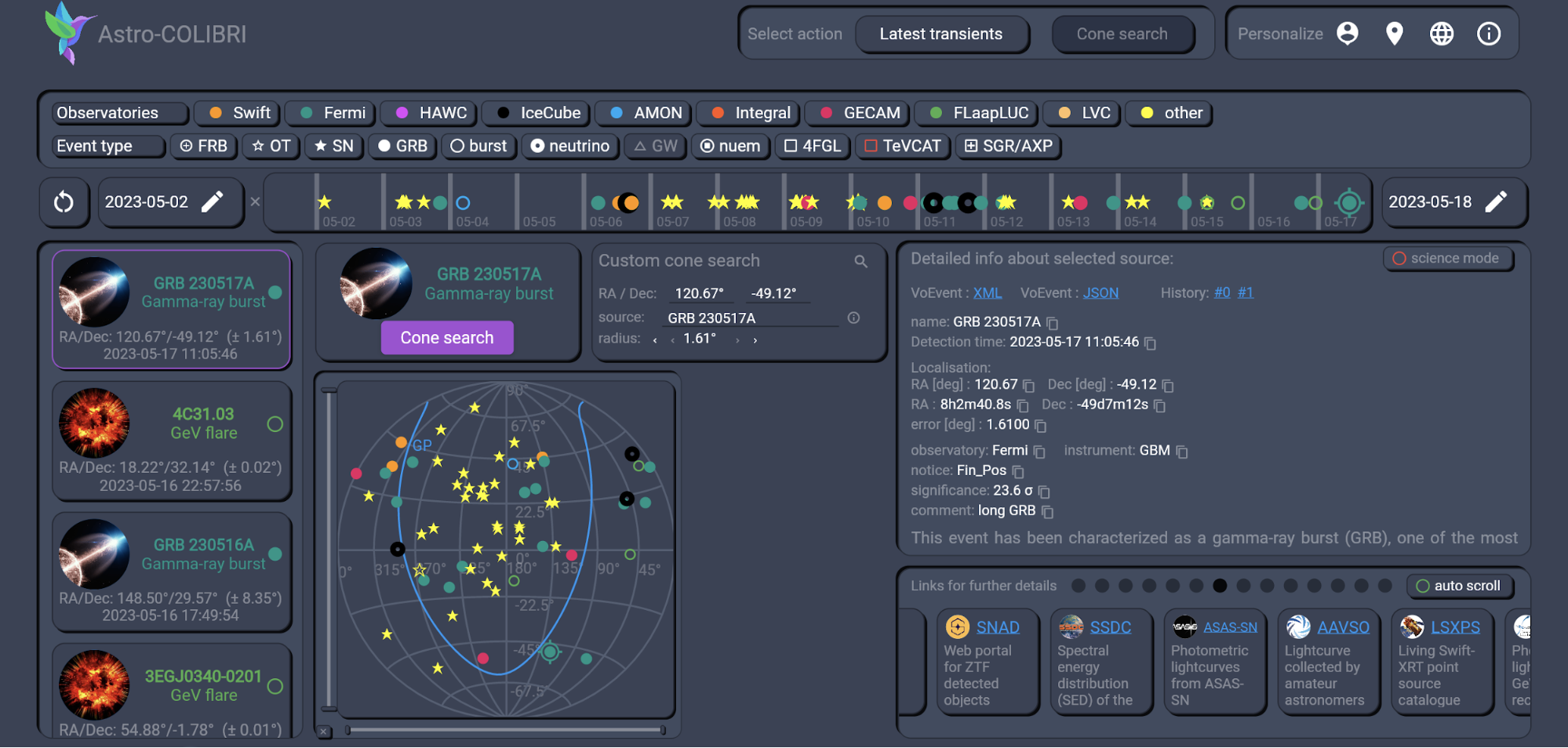Astro-COLIBRI
The COincidence LIBrary for Real-time Inquiry for multi-messenger astrophysics, called Astro-COLIBRI, is a novel platform for multi-messenger astrophysics https://astro-colibri.science/. It provides real-time insights into the most extreme astronomical phenomena, helping users quickly identify and observe events across various bands, messengers, and timescales.
Astro-COLIBRI covers a wide range of astrophysical sources, such as Active Galactic Nuclei (AGN), Gamma-ray Bursts (GRBs), Fast Radio Bursts (FRBs), Gravitational Waves (GWs), High-energy Neutrinos, Optical Transients (OT), Supernovae (SN). It incorporates multi-messenger services, catalogs, and alerts from various observatories and systems facilitating collaboration, coordination and data sharing among the astronomy community.
The state-of-the-art architecture and user-friendly interface ensure easy access and use by experienced astronomers as well as those simply curious about the mysteries of our universe.
The website is available at https://astro-colibri.com and the smartphone apps can be found in the relevant app stores (Android / iOS). Further information and tutorials are available on the dedicated YouTube channel or on Twitter: @AstroColibri.

Einstein Telescope Perspectives
The Einstein Telescope (ET) is a proposed underground infrastructure to host a third-generation, gravitational-wave observatory which was included in ESFRI in 2021. Its greatly improved sensitivity and access to lower frequencies with respect to the second-generation laser-interferometric detectors Advanced Virgo and Advanced LIGO will make it possible to explore the Universe through gravitational waves along its cosmic history up to the cosmological dark ages. ET is expected to detect 100000 binary neutron star mergers and the same amount of binary stellar-mass black hole mergers per year enabling us to understand their origin, evolution and demography of binary systems of compact objects. It will open the realm of primordial black holes directly coming from the fluctuation in the density of the Universe. It will probe the physics near black-hole horizons (from tests of general relativity to quantum gravity), the nature of dark matter and the nature of dark energy, and it will enable testing possible modifications of general relativity at cosmological scales. ET will provide an unprecedented insight into the interior structure of neutron stars probing fundamental properties of matter in extreme conditions. It will be a revolutionary exploratory machine to know the unknown.
ET will operate together with a new innovative generation of electromagnetic observatories covering the band from very high-energy gamma rays to radio (such as CTA, Athena, the Vera Rubin Observatory, E-ELT, the Square Kilometer Array). One goal of the AHEAD2020 project is to develop pilot science studies able to drive the design and to optimize operations of the new generation of multi-messenger observatories.
A series of studies have been recently developed with the AHEAD2020 contribution to evaluate perspectives of the next generation of gravitational-wave detectors observing in synergy with electromagnetic observatories:
- Ronchini et al. comprehensively investigate the perspectives of ET operating with high-energy satellites (Fermi, Swift, SVOM, GECAM, THESEUS, HERMES, Gamow, Einstein Probe, TAP, Athena) considering both the prompt and afterglow emission and different observational strategies (survey and pointing mode). An astonishing results is that almost all short GRBs detected in the ET era will have a gravitational-wave counterpart;
- Banerjee et al. evaluate the outstanding capabilities of ET of detecting binary neutron stars before the mergers. Pre-merger detections are vital to detect the prompt very high energy emission expected from binary neutron star mergers. This work sets the base of the synergy among ET and CTA
- Branchesi, Maggiore at al. is the updated reference science case paper for ET. It provides a comparison of different designs for the Einstein Telescope considering the single triangular geometry and a network of two L-shaped detectors with different choices of arm-length and access to low-frequencies. The work evaluates metrics such as detection efficiency, horizon, estimates of parameters of compact binary coalescences, and perspectives for early Universe science, stochastic backgrounds, nuclear physics and cosmology. It includes detailed study that has been developed on the multi-messenger science for the different designs. This work represents a milestone on defining the best ET design on the basis of an extensive science evaluation.


